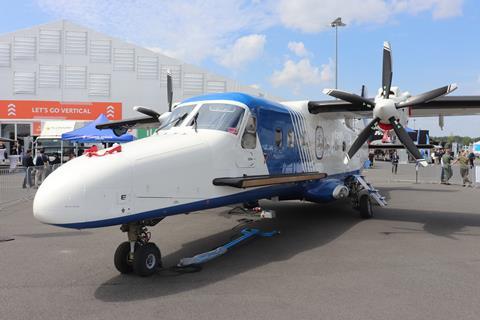General Atomics AeroTec Systems (GA-ATS) is planning to build at least 25 of the latest NXT variant of the Dornier 228 after it acquired the programme from Switzerland’s RUAG Aerospace Services.
Deliveries of the new edition of the utility twin-turbprop, which will be assembled at GA-ATS’ facility in Oberpfaffenhofen, near Munich, Germany, are due to begin in mid-2025.
“The message we are sending to our customers and the market is that we can deliver again next year,” Harald Robl, GA-ATS chief executive officer, told FlightGlobal at the ILA Berlin air show on 6 June.
The company has ordered parts for the first 25 aircraft, and is planning on producing five per year, adds Do 228 NXT programme manager Martina Hierle.

“We are taking pre-orders and half of the first year’s production is signed and sealed,” says Robl. “We are working hard to continue that [trend].” Both European and Asian clients, current customers and new buyers, have shown interest in the new aircraft.
According to Cirium fleets data, 111 examples of the old Dornier 228 are currently in service.
As it launches the new production line, the company is looking to hedge against supply chain issues which have plagued the global aerospace industry in recent months.
“We are trying to do as much in-house as possible,” Hierle says. The goal is to build up partnerships in Europe and the aircraft’s fuselage, for example, comes from Potez Aeronautique in France.
CUSTOMER FEEDBACK
The Do 228 is operated primarily by military and government law enforcement organisations for patrol, research, surveillance and reconnaissance as well as light transport operations of cargo, paratrooper and medevac purposes. It is often used in special mission operations at low-level altitudes up to 25,000ft.
“It is a robust aircraft. We have received feedback from customers and have turned that feedback into a specification and we are further optimising the aircraft for our customers,” she adds.
The Do 228 NXT, which can carry up to 19 people in its passenger configuration, or up to 21 paratroopers and a jumpmaster, is powered by a pair of Honeywell TPE331-10 engines which, according to Hierle, are currently the “best-in-class”. But should customers request more sustainable solutions with alternative propulsion technologies, GA-ATS would consider that.
“We are extremely flexible, we adapt to the market,” she says. “But you have to consider where this aircraft is used and what for. It flies in Africa, Nepal, Southeast Asia, in other developing countries, and they need a very tough aircraft.
“We always get the question if we will build it in carbon composite, and we have decided against that, on purpose,” Hierle adds. “Our customers load the aircraft with forklifts, and if there’s an accident, the damaged panel just gets replaced, and they continue normal operations. That doesn’t work with carbon composites.
“It is the same thing with batteries, electricity or hydrogen. Where will you get hydrogen in Africa? The infrastructure just does not exist yet.”
In late May, the company said that the in-house prototype phase of wing production was “successfully completed a few weeks ago”, and series production of Do 228 NXT wings is now underway. Assembly of the entire wing is to follow.
General Atomics acquired the Do 228 programme in February 2021 when it bought what was then RUAG Aerospace Services, subsequently renaming it GA-ATS.


























